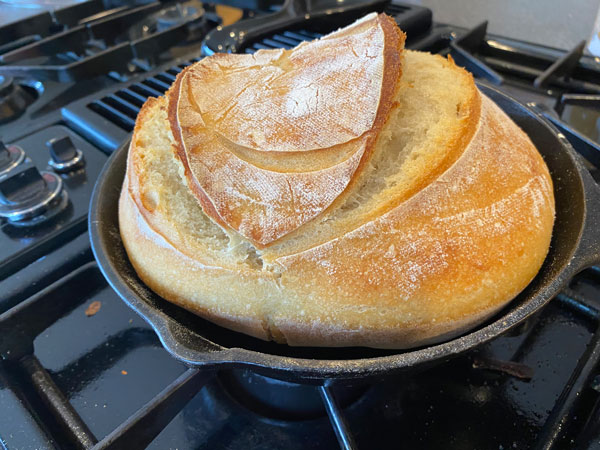Last updated: 14-May-2021
Like my ability to create a delicious loaf of sourdough bread, this post is a work in progress. I’m hitting the publish button to give myself these materials as a resource. I expect to update the content of this post in due course. (Yes, it doesn’t have all the content even close to done, but hey ho, here I go!)
The Story
During the COVID-19 lockdowns, I got into making a starter sourdough, like so many other folks. My early efforts at baking sourdough bread were a mess. Yet, I was eager to keep going and learn more.
A friend, Norma Miller, shared wonderful photos of the breads that she had been baking. So I asked her to share her tips and guidance. What she shared is in the video below from Pro Home Cooks. I’m now working the tips and guidance from the video into my own efforts. As of this posting, I don’t have much to show of it yet, but this post is a way to help me learn about making better sourdough bread.
Ingredients: Baker’s Percentages for Liam’s Loaves
This is the formula of ingredients that I’ll use for my sourdough bread as I learn.
- 1000 grams of flour
- 800 grams of water
- 150 grams of starter dough
- 20 grams of salt
15 Mistakes Most Beginner Sourdough Bakers Make
Video Time Stamps
- Tip 1: Have a healthy and active sourdough starter (0:50)
- Tip 2: Autolyse your bread for at least 45 minutes (3:47)
- Tip 3: Using baker’s percentages (4:45)
- Tip 4: Lowering your hydration level (6:12)
- Tip 5: Knowing when to use your starter dough (7:38)
- Tip 6: Stretch and fold the dough (10:32)
- Tip 7: Knowing when your stretch and fold is done (10:49)
- Tip 8: Let the dough proof on your schedule (11:36)
- Tip 9: Ratio of dry to sticky (12:58)
- Tip 10: Generously flour the proofing banneton or bowl (14:12)
- Tip 11: There is no perfect way to shape the dough (11:44)
- Tip 12: How do you know when the dough is ready to go in the oven? (16:29)
- Tip 13: Use of a cookie sheet helps prevent burnt bottoms (18:35)
- Tip 14: Go off the color and not the timer (19:02)
- Tip 15: Don’t be afraid to screw up or fail (19:48)
Sourdough Bread Baking Tips
1. Have an Active Starter Dough
- Feed the starter dough every day
- Mix flour and water of a ratio of 1:1 (75 grams of water; 75 grams of flour)
- On baking day, feed the yeast 3-5 hours at room temp before cooking
2. Autolyse the Bread
- Mix flour and water
- Let sit for 45 minutes
3. Mix in the Starter Dough
- Stretch and fold for a while
- Then come back and do it again every 30 minutes for 2 hours
4. Bake it in a Dutch Oven
- Preheat the oven itself and the dutch oven to 550º F
- Use parchment paper to line the pan
- Cook with the top on for 20 mins
- Then take the top off and bake for 25 mins at 450
- Tip: add an extra baking sheet under the dutch oven to help prevent burning of the bottom
- Finally, turn off the oven, and crack the oven open slightly, and let the bread it in the oven for 20 minutes
A New Recipe: From My Brother’s Kitchen
In early May 2021, I was lamenting to my brother that since getting into sourdough, I have never really made a loaf of sourdough that was of really good quality. Sure, they were all tasty, but none was anything that I would categorize as “there”. I shared that I had pretty much resolved myself to making fantastic sourdough pizza, but would leave bread alone.
In response, my brother – who is a great cook but who never uses recipes for anything – shared his rough formula for making sourdough bread. Like the baker’s percentages above, this one is all by the numbers to make a single loaf of sourdough bread:
- 4 cups of flour
- 1.0 cup of sourdough starter
- 1.5 cups of water
So, the ratio of flour to starter dough to water is 4:1:1.5.
When I made that recipe, my brother’s informal recipe, I got a much better rise out of the dough. I cooked the bread at 425º F in a 6.5″ Lodge cast iron pan for about 35 minutes. The bread was a little under-done, but I can work on that. Onwards and upwards to making that great loaf of sourdough bread!
Contains affiliate links.


